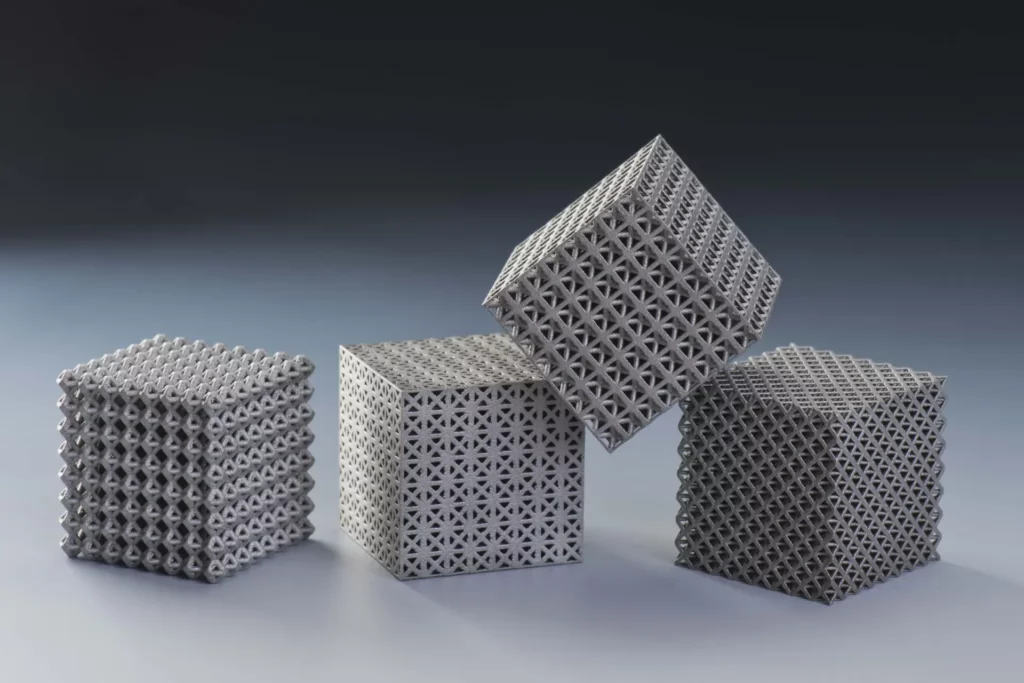Lattice structures refer to repeating units of open two or three-dimensional cell structures that are topologically arranged for specific mechanical and functional purposes. They consist of numerous beams, nodes and struts networked to enhance parts both visually, physically and functionally.
Additive manufacturing (3D printing service) allows many design experts to play around the intricate internal geometries of many materials and unlock the capabilities of such materials for improved mechanical properties and performance. By making simple modifications to the design of 3D parts, lattices can convey excellent strength, shock absorbance and weight reduction to printed objects without compromising structural integrity.
Through lattice structures, design experts may lower the weight of an object by nearly 90 percent. Curious as to what else you can achieve with latticing your parts? Read on to find out all the ways you can improve your 3D printed lattice structures.
Why use Lattices?
In summary, the benefits of latticing 3D printed parts (3d printing service providers) consist mainly of structural advantages, visual aesthetics and weight reduction. The application of lattices in 3D objects help to form a superb structure and micro-architecture of beams and nodes that interlink for an overall improved part finish. Below are all the advantages to latticing your 3D printed part:
Structural advantages
3D printed objects that are designed with lattices will boast of excellent strength and structural integrity. These structures will take advantage of the spaces in between the design, the complex nodes and super structure of networked materials to deliver more impact and shock absorbance. Unlike fully solid materials, latticed objects will not spread the shock wave all over the part, helping to reduce the chances of overall damage.
When properly designed, the lattice spaces may also be made to house rubber-like or other shock-absorbing material that will act as a secondary expellant of shock. Simple modifications to the positions and thickness of the nodes, beams and struts can help improve how the components of the design interact with certain types of forces. Parts that have big lattice structures will demonstrate high elasticity and flexibility, making it less brittle and less likely to break.
Lightweight parts
Unlike conventional machining where weight shaving is only possible in non-critical areas, latticing in additive manufacturing allows for significant weight reduction all over the part. With lattices, engineers can achieve a higher strength-to-weight ration for their design. The partial hollowness of the lattice means that many cells within the object with empty spaces. These spaces are devoid of material which means that the overall weight of the part is lesser than a similar fully solid part without lattices.
Cost and material saving
Latticed 3D printed objects will be lighter than their all-solid counterpart. This is because there is lesser material utilized in the production of latticed parts. This consequently translates into lower cost and material savings.
The effect of using less material is often emphasized in applications such as automotive and aerospace where reduced weight can impact fuel consumption, speed and engine performance.
Noise and vibration dampening
In most mechanical operations, noise and vibration are often critical to user experience and engine performance. 3D printed lattices allow design experts possibilities for noise dampening and vibration reductions. Because of their structures, lattices excellent for dissipating vibrations. They are also ideal to withstand the strain from high vibrations without intensively transmitting these vibrations to other parts of the object. The same is true for sound energy and heat exchange and dissipation when latticed structures are placed into 3D printed parts.
Visual aesthetic and appearance
Asides the myriad mechanical and structural advantages that come with latticing 3D printed objects, parts with lattices have certain visual appeal and aesthetics that make their design more appealing. Lattices can be used to deliver visual improvement on parts that would otherwise appear bland and boring.
The visual appeal of latticing is seen in many structures like the Eiffel Tower. The thin nodes and beams that are present in these objects can help convey transparency and appeal without compromising on the strength of the material or design. The complex latticing that accompanies the printed object may yet be the only design in the part but remain as visually arresting as other simple parts with complex designs.
Firstpart 3D Printing Solutions
Firstpart (3d printing service providers) offers a wide range of 3D printing solutions for both personal, commercial and industrial uses. Choose from a variety of printing options, filaments and finishes to produce high-quality parts that are suitable as production parts, prototypes or end-use devices. By simply contacting us, we can print and ship your parts to you anywhere in the world.
If you are relatively new to work with lattices in 3D design, we invite you to work with us and take advantage of our expertise. At Firstpart, we can help to optimize the performance of your design by including aesthetically-pleasing and highly-functional lattices that ensures an improved overall part performance. Click here to request a free quote or click here to contact us now and get started with your project!










